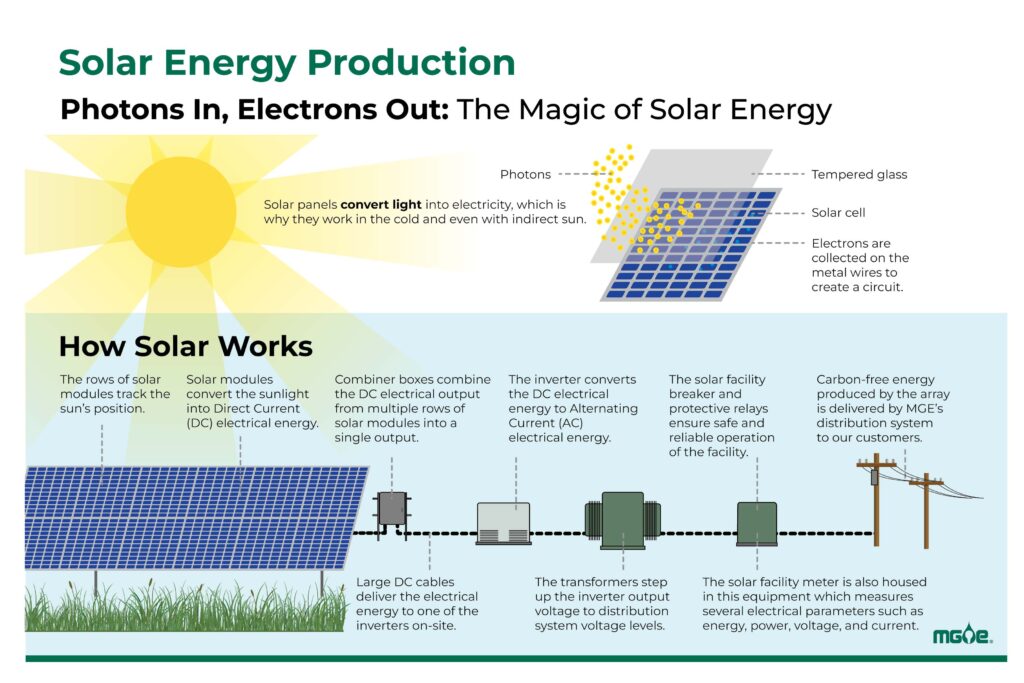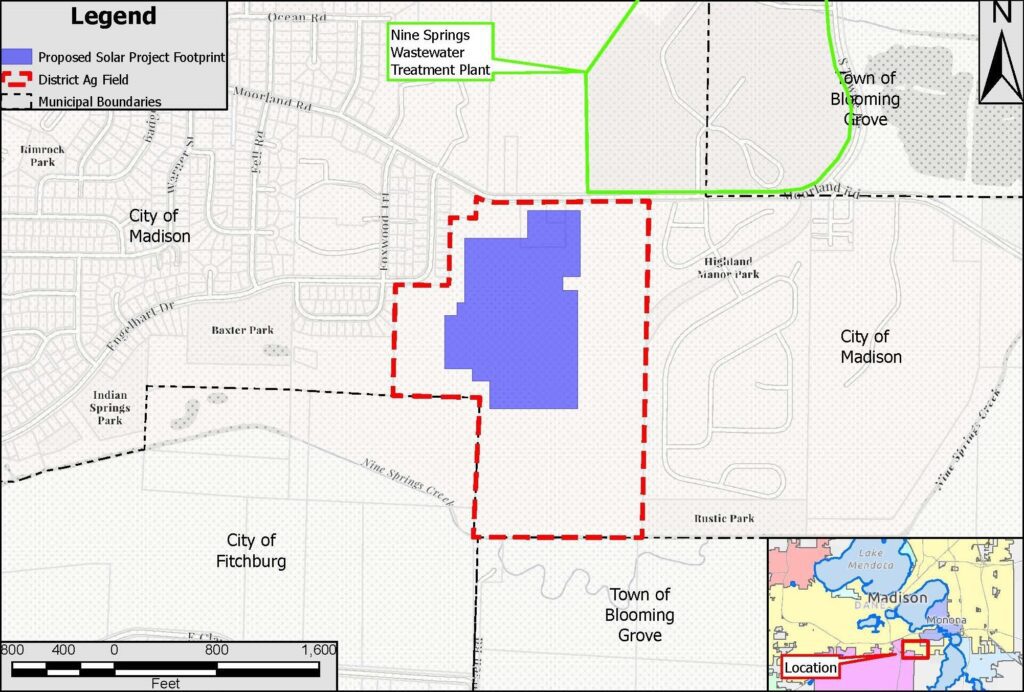Bringing clean energy to the regional power grid
The District and Madison Gas and Electric (MGE) share a common interest in renewable energy and sustainability. MGE is working to decarbonize the electricity it supplies to customers. By 2030, on behalf of all customers, MGE expects to deliver electricity with 80% fewer carbon emissions, and by 2050, MGE expects to deliver net-zero carbon electricity. While the District reuses waste heat, captures and reuses biogas, and generates a small amount of solar energy, we’re seeking additional ways to contribute to renewable energy production and be a more sustainable community partner.
Through the partnership, the community benefits from locally generated, carbon-free and cost-effective energy. The land surrounding the solar project will be maintained with a perennial cover, with the ability to be harvested, to preserve farmland. Additionally, maintaining perennial cover will benefit water quality by keeping phosphorus in the soil where it belongs. When phosphorus is able to enter neighboring waterways, it contributes to algae growth and poor water quality.

FAQs on the solar project
Here are some of the more common questions regarding the installation of the Nine Springs Solar Project.
Project overview and technical details
How does solar energy collection work?
Solar panels capture sunlight and convert it into electricity through the photovoltaic effect. When sunlight strikes semiconductor materials in the panels, electrons are excited, producing direct current (DC) electricity. That DC power is then fed into a solar inverter, which converts it into alternating current (AC) for use on the grid or by electrical systems.
Additional information is available at www.mge.com.
Why is the District partnering with MGE instead of building and operating the solar array itself?
The District is partnering with MGE because building, financing, and maintaining a utility-scale solar installation requires significant capital investment and specialized operational expertise. Under this partnership, MGE is better positioned to utilize its resources and expertise to handle all aspects of development, integration with the electrical grid, ownership, and ongoing maintenance.
Will the District use the energy from the Nine Springs Solar project in its own operations?
While the solar energy generated will be delivered to the regional power grid, not directly to the treatment plant, it contributes to the overall supply of clean energy in the community. This aligns with the District’s sustainability goals and reduces regional carbon emissions. The District continues to reduce its own energy footprint through on-site initiatives like biogas reuse, rooftop solar, and waste heat recovery.
What is the size of the project, both in megawatts and land area?
The Nine Springs Solar array is expected to be 8 megawatts, providing enough energy to power about 1,750 households each year (based on typical MGE residential customer electric usage of 6,000 kilowatt-hours a year), which could power upward of 1,344 average U.S. homes per year. It is expected to offset approximately 9,450 tons of carbon dioxide (CO2) emissions annually.
The entire tract of land is 94.5 acres. The solar project’s footprint is approximately 37.4 acres.
What is the overall timeline for installing the solar array, and what are the key milestones?
Through Summer and Fall 2025, the District will work with the City of Madison’s land use permitting process to rezone two small parcels on the site to agricultural use to achieve contiguous zoning across the property. The majority of the site is already zoned for agricultural use, and solar energy installations are a permitted use on agricultural-zoned lands.
The District will then lease a portion of the land to MGE. Construction is anticipated to begin in late 2026, and the site is expected to begin producing energy in 2027.
Who oversees this project within the District, and what partners or regulatory agencies are involved in ensuring compliance with laws and regulations?
The District is handling the rezoning application and land lease. MGE will select a developer to develop and construct the solar array, and once complete, it will own and maintain the solar installation.
The District is working with the City of Madison and following its process to ensure compliance with land use requirements. Given the size of the solar installation, it is not necessary to file an application for the project with the Public Service Commission
Will there be other solar-related infrastructure upgrades planned by the District?
Not at this time.
However, the District does have an existing 100-kilowatt solar installation on the roof of its Maintenance Facility. This installation generates approximately 75% of the power used by the Maintenance Facility and avoids about 98 tons of CO2 emissions annually. Additionally, it saves the District about $10,400 annually in electricity costs.
View our solar array monitoring tool to see part of our system performance and environmental savings. (Note that this monitoring tool only reflects the newer, 80kw portion of the District’s rooftop installation; 20kw was installed when the facility was built, and 80kw was installed in 2024.)
What measures will be undertaken to ensure public safety during construction and ongoing solar operations?
As it has previously, with numerous construction projects in the region, MGE will work with its selected contractor to ensure that the necessary safety measures are implemented during construction. A fence will surround the project once it is complete, and it will only be accessible to personnel who have been trained to enter solar farms safely.
Will the project affect sewer utility rates, and if so, how?
This project will not increase District rates as the District is not paying for the construction, operation or maintenance of the project. The District will receive a small amount of revenue for the land lease.
Energy use and solar generation
How much energy does the District use annually?
In a typical year, the District uses just over 33 million kilowatt-hours (kWh) across its 17 facilities in the MGE service territory. By comparison, the new solar array is expected to produce over 15 million kWh annually, thereby offsetting the District’s current electric load by 46%.
In what other ways does the District offset its energy consumption?
The Nine Springs Wastewater Treatment Plant recovers approximately 276 million cubic feet of biogas per year; in fact, the plant recovers enough biogas to supply more than 2,290 homes annually. This biogas is cleaned onsite and then used to power plant equipment, such as blowers, generators and boilers.
The District also captures waste heat from large machinery, such as generators and boilers, to heat process water used at the plant.
As an organization, the District continually seeks ways to enhance its energy efficiency and increase its use of clean, renewable energy. We use multi-year plans to help guide the District as it considers upcoming aging infrastructure replacement projects.
Is this a permanent installation? How long will solar panels be generating energy at Nine Springs Solar?
The District owns a tract of land across Moorland Road from the Nine Springs Wastewater Treatment Plant that it has retained for future plant expansion. As that land will not be needed for a few decades, the District has decided to partner with MGE to lease a portion of the land to install a solar array for at least 20 years.
Residential and community impact
In what ways might the installation of the solar array affect nearby residential neighborhoods?
There are no anticipated long-term impacts to the neighboring residential neighborhoods. Solar panels produce no emissions as they produce electricity, and solar arrays require minimal maintenance.
Will a detailed map or visual guide showing the specific areas or addresses impacted by this project be available?
A general map showing the proposed location of the solar project is available here. Once MGE has finalized a contract with the developer, a more detailed map will be made available.
Could the solar panels create glare or other visual impacts that might affect nearby homes or roadways?
A common misconception about solar PV modules is that they inherently cause or create a lot of glare, posing a nuisance to neighbors and a safety risk for pilots. While in certain situations the glass surfaces of solar PV systems can produce glint (a momentary flash of bright light) and glare (a reflection of bright light for a longer duration), light absorption, rather than reflection, is central to the function of a solar PV panel. PV modules absorb solar radiation that is converted to electricity. Solar PV modules are constructed from high transmission, low iron glass and are covered with anti-reflective (AR) coatings. Modern PV modules reflect as little as two percent of incoming sunlight, about the same as water and less than soil or even wood shingles.
Glint and glare have not been an issue on past solar projects built by MGE; for example, Dane County Solar was installed next to Dane County Airport, along Highway 51. That project has not received any complaints about glare.
How might the construction process and the long-term operation of the solar project influence local property values?
There have been no comprehensive studies on the impact of solar projects on local property values in Wisconsin.
Research by the Solar Energy Industries Association (SEIA) found that “large-scale solar arrays often have no measurable impact on the value of adjacent properties, and in some cases may even have positive effects.” At a maximum of 8 megawatts, this solar installation is relatively small in scale. The Association also notes that proximity to a solar installation does not deter the sales of agricultural or residential land.
Should residents expect additional local traffic, noise or other disruptions during construction or once the projects are completed?
During construction, additional noise typical of construction projects may occur. Traffic impacts are anticipated to be limited to a narrow portion of Moorland Road as District property north of Moorland will be used as a storage and staging site during construction.
Once the project is completed, this site will be managed remotely, with around one or two operations and maintenance staff arriving when planned or unplanned maintenance is required. This means that traffic to the site during operation will be minimal. The inverters, which are cooled by internal fans (which, on some projects, can contribute to increased noise levels at the property line), are located within the center of the site. Due to the distance from the property line to the inverters, the neighbors should not be able to hear the inverters running. The solar panels will be following the sun throughout the day on single-axis trackers. It is not expected that these trackers will contribute to noise at the property line.
Will the installation temporarily disrupt essential services such as electricity for nearby residents?
No.
How far will the project be set back from property lines?
In its preliminary design, the project is expected to have a setback of around 90 feet from the western property boundary to the site fence and over 400 feet from the eastern property boundary to the site fence.
Community involvement
How will the District share project information with the community and what opportunities will residents have to participate?
The District provided notification to the area alder, business association and adjacent neighborhood associations in late June.
Additionally, the District, along with MGE, hosted an open house on Tuesday, August 12, from 4 p.m. to 6 p.m. at our Maintenance Facility, located inside Gate 4. This was a drop-in event where interested individuals learned more about the project and the District. Postcards with meeting information were sent to residents near the planned project area.
Updates and information are also found on this webpage at madsewer.org/ns-solar.
How can I ask questions?
Please direct your questions to District staff through our contact form. We can help route your questions or feedback to the appropriate individual or organization.
Receive Project Updates
Sign up here to receive email updates from the District on this project and other projects in the area.
* indicates required fields








